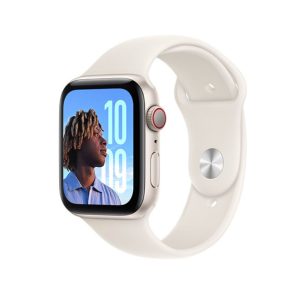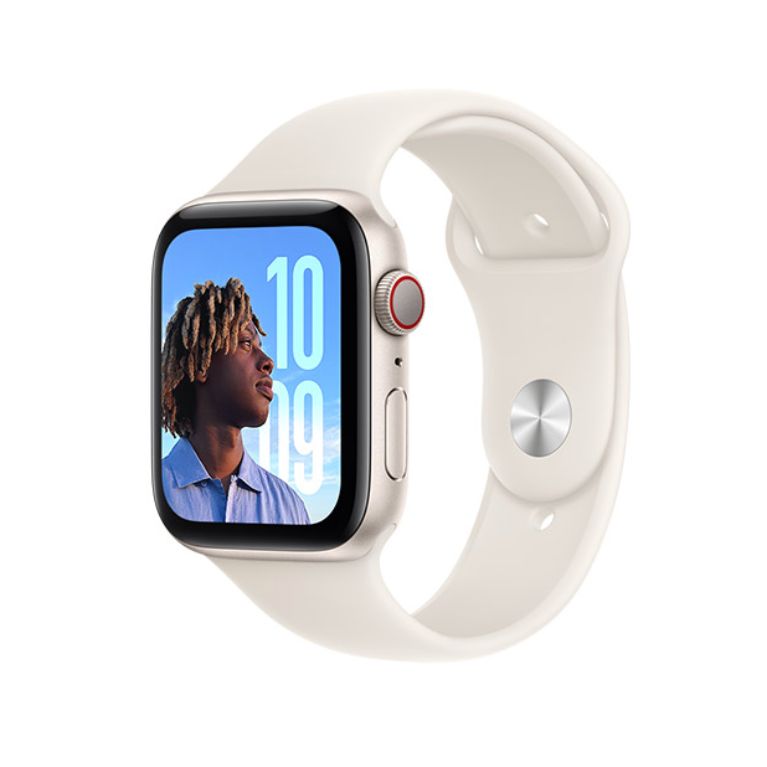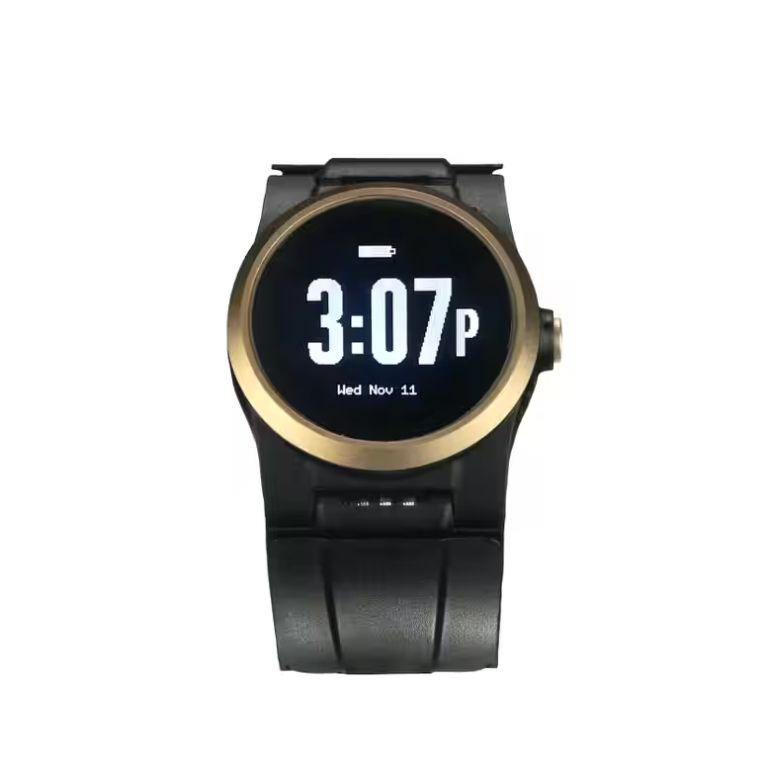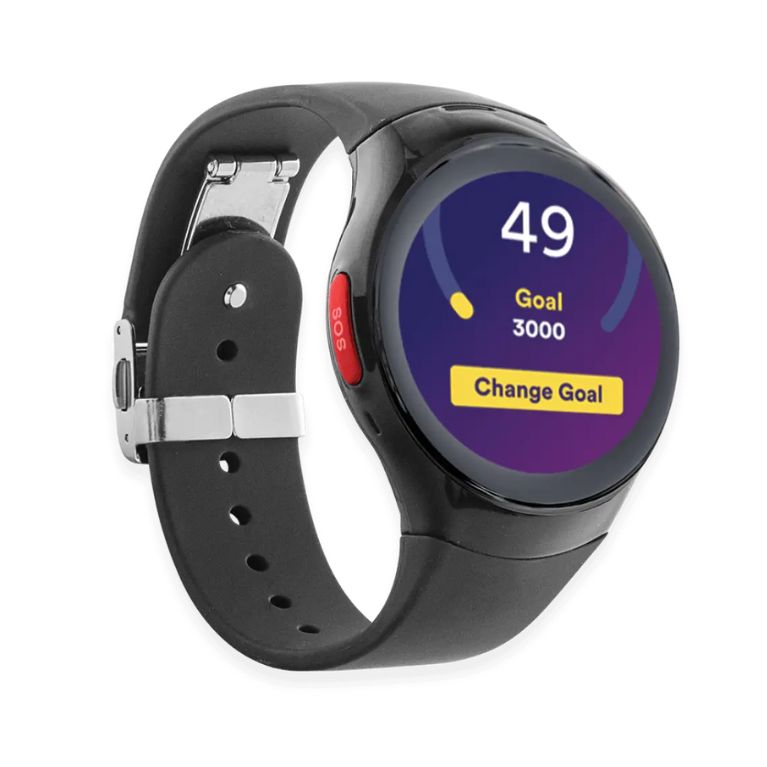Your likelihood of falling increases as you age, with about 14 million people—or one in four older people—falling each year. (1) And though not all falls result in injury, falling is still a leading cause. About 37% of people who fall report an injury that requires medical assistance. (1)
For this reason, fall-detection devices, like the Apple Watch, are gaining popularity. Not only can this device detect the majority of hard falls, but it also can alert emergency services that help is needed. The watch even alerts family members or emergency contacts that their loved one has fallen and may need assistance. (2) Even more importantly, these devices allow people to remain independent and stay at home—especially since wearing a device with fall detection builds confidence and allows the peace of mind to remain active. (3)
If you’ve been considering purchasing an Apple Watch for you or a loved one but are unsure if it’s the right fall-detection device for you, we’ve got you covered. Below, you’ll find everything you need to know before purchasing the Apple Watch SE for its fall detection capabilities.


Key product features
What you should know
The Apple Watch is a customizable watch that pairs with your iPhone and offers several health monitoring features, including fall detection. This watch helps detect hard falls and motivates users to stand, exercise, and move around—all of which are important parts of healthy aging. It even allows you to answer calls, respond to text messages, and listen to music while on the move.
- Apple Watch has a sleek design and easy-to-use interface, allowing iPhone users to track steps, log workouts, monitor their health, and stay active with peace of mind.
- Unlike other medical alert watches, fall detection is included with the Apple Watch, so there is no additional monthly fee.
- The Apple Watch is ideal for people who want fall detection and a number of other health monitoring tools, such as heart rate monitoring, activity tracking, and sleep monitoring.
- Apple Watch comes in two sizes, and its look is customizable, meaning you can choose the face and band, combining the color patterns of your choice.
- Apple Watch also comes equipped with the ability to detect a car crash and will notify emergency services just like it does with fall detection.
Apple Watch fall detection overview
Suppose you’re looking for a fall detection device and are considering the Apple Watch SE. In that case, you may be surprised to learn that despite its advanced technology, it’s still an easy-to-use device that can add peace of mind while also encouraging the wearer to remain active.
In fact, research shows that wrist-worn technologies like the Apple Watch not only increase daily step counts but also encourage exercise tracking—both of which can help prevent falls in the future. (4) Plus, researchers have also learned that wearing a fall detection device gives people control over their well-being and may boost their quality of life. (4)
This is particularly important as you age because fear of falling during normal, everyday activities or while exercising—especially while living alone—often keeps people from moving around as they should. (5) We found the Apple Watch does a good job of promoting movement while reducing the fear of not being able to get help when it’s needed.
We especially like that the watch interacts with the wearer, particularly when they experience a hard fall. Not only does the watch “tap” the person on the wrist, but it also emits an alert that gradually gets louder. This alarm-like sound may rouse the wearer and can alert those nearby that you need help. If you don’t respond, or if the watch senses you’re not moving, it will begin a 60-second countdown to call emergency services. The watch can even let them know where you are using its GPS system, regardless of whether your iPhone is nearby.
We also like that after the emergency notification is made, the device will alert your emergency contacts that you have fallen and tell them where you are located. So even if you are outside of your home and away from your iPhone, the people who care about you can still find you and come to your side. (Just make sure to set up your emergency contacts in your iPhone when you get your watch, otherwise it will not know who to contact.)
As a bonus, you have the option of contacting emergency services on your own with the watch’s SOS option. This means if you’re concerned that you’re having a heart attack, stroke, or other medical emergency, you don’t have to wait for a fall to alert emergency services. You simply press and hold the side button until the slider appears. Then, drag the emergency call slider to the right to make your call—and it will work even if you don’t have your phone nearby.
In addition to its fall detection capabilities, we particularly appreciate that the Apple Watch can also detect a severe car crash such as front-impact, side-impact, rear-end collisions, and rollovers that involve sedans, minivans, SUVs, pickup trucks, and other passenger cars. The watch goes through the same sequences as it does during a fall and will alert emergency services in 20 seconds if you don’t respond to the “tapping” on your wrist. So, if you’re considering this watch for its fall detection capabilities for a loved one who still drives, you’ll likely appreciate that it can call for help in a car crash if your loved one is not conscious.
This is an important safety feature for older people, especially since their age-related frailty increases their risk of death if they’re involved in a car accident. (6) Having a device that can save time and get them medical help sooner can be a life-saving investment.
Apple Watch also impressed us with its other health monitoring and health-promoting tools. For instance, this device reminds people to stand every hour (and will record a stand after one minute of movement), keeps track of movement, and tracks steps. It’s even designed to partner with you when exercising to monitor your heart rate and how hard you’re working—all of which can be useful data to share with a healthcare provider if needed.
We especially like the fact that the watch can track your heart rate and sleep hygiene. For instance, you can check your heart rate any time you want. You’ll also get notifications for high or low heart rates and irregular rhythms, which may prompt you to see your healthcare provider if you notice a pattern. However, keep in mind that you must set a heart rate threshold to receive a notification of a high or low heart rate while inactive. If you want to be notified of irregular heart rhythms, you will need to set up these notifications as well.
If worn to bed, the watch can also help you improve your sleep. Not only can you create sleep reminders, but you also can see how much time you spend in different sleep stages, like REM sleep and deep sleep. It also can estimate when you woke up and show your sleep trends over the last 14 days. With the Sleep Focus setting, you can reduce distractions from your iPhone and Apple Watch. Most importantly, the watch has a feature that was approved by the Food and Drug Administration to detect sleep apnea. This type of data is useful in addressing sleep disorders, which are common in older people and can lead to health issues. (7)
But despite all its positives, the Apple Watch has some downsides, particularly if you’re considering it for its fall detection capabilities. First, you must have an iPhone for the Apple Watch to work. So, if you have a Samsung or Google phone, the Apple Watch will not work with it.
And though this watch is intuitive and easy to use, it may be challenging for people who struggle with navigating technology. Likewise, those with cognitive decline, memory issues, or other types of neurological conditions may not benefit from having an Apple Watch.
We are also concerned that the watch may not be able to detect soft falls, such as dropping to a knee before slowly falling to the side. If soft falls are a risk, a different type of fall detection device might work better.
What customers are saying
People who have purchased the Apple Watch SE note that it does a decent job detecting falls and is easy to navigate. That said, it also tends to be sensitive and may detect movements that are not truly falls. This can result in some false alarms.
For instance, Tom A., a verified reviewer on Quora, notes that though he and his wife have not fallen, the watch’s fall detection has been triggered several times. Even the simplest movements can cause a false alarm that needs to be addressed before emergency services are contacted.
“Mine has been triggered three times, twice when taking off my watch and putting it on the charger,” he says. “So I’d say it’s not perfect. But it’s useful enough that we are glad we have them.”
Still, Tom says he would recommend the Apple Watch for those 65 or older, especially since falls can be life-threatening. In fact, older people have the highest risk of death from a fall. They also run the risk of a serious injury. (8) In the U.S., 20% to 30% of people who fall suffer injuries such as hip fractures, head trauma, and bruising. (8)
Steve L., another verified viewer on Quora, had a similar experience. “I plopped down on the ground just a few days ago to fix something on my motorcycle, and I started hearing a beeping from my watch. I looked at the watch face, and it was asking me if I’d fallen and giving me a countdown to answer before it called 911 on my behalf!”
Specs
| Price | $249+ |
| Response time | Approximately 60 seconds |
| Battery life | 18+ hours |
| Material and case | Aluminum |
| Battery type | Rechargeable |
| Charging time | 100% charged in 2.5 hours |
What are fall detection devices?
Fall detection devices usually fall within one of two categories: wearable devices and ambient sensors (or devices that detect environmental changes). Wearable fall detection devices like watches or pendants have accelerometers that detect rapid downward movements like a fall. They also may include a manual alert button for help if the device does not detect a fall. (9)
How does fall detection work on the Apple Watch?
When an Apple Watch detects a hard fall, it will “tap” you on the wrist with a vibrating buzz. It also will sound an alarm and show an alert. You can choose to connect to emergency services or dismiss the alert by pressing the button on the side of the watch. You can also tap to close the alert or “I’m OK” to dismiss the alert.
If your watch senses that you are moving, it will wait for you to respond. But if you do not move for 60 seconds, your Apple Watch will begin a 30-second countdown while it taps you on the wrist and sounds an alert. The alert will gradually get louder so that you can hear it, or someone near you will hear it. Unless you or someone else presses the cancel button, your watch will automatically contact emergency services when the countdown ends.
Apple Watch also will contact your emergency contacts. These contacts are taken from your iPhone, which you set up in advance. (Make sure you set this information before using the watch.) Your watch will also share your current location as latitude and longitude coordinates using Apple’s GPS location monitoring feature. Then, everything is logged into your Health app.
How to set up fall detection on the Apple Watch
To set up fall detection on your Apple Watch, you can use your iPhone or navigate the steps on the watch itself. Remember that fall detection is turned on automatically for people who are 55 or older who set up a new Apple Watch with watchOS 8.1 or later (as long as you entered your birthday when setting up the watch). Here are the steps for setting up fall detection directly on your watch if it’s not automatically set up:
- Open the Settings app on your Apple Watch
- Go to SOS > Fall Detection
- Turn on Fall Detection
- Choose “Always on” or “Only on during workouts”
You can also turn on fall detection on your iPhone by opening the Apple Watch app, tapping My Watch, tapping Emergency SOS, and then turning on fall detection. Keep in mind, too, that turning off wrist detection will keep your watch from automatically attempting to call emergency services even if it detects a hard fall, so you want to keep that feature on.
Who is Apple Watch fall detection recommended for?
Apple Watch’s fall detection is recommended for anyone 18 and older at risk of a fall. For instance, people with medical conditions that put them at risk of falls may find the watch useful. Likewise, older people with balance or mobility issues may also find the watch helpful. Even people who live alone or exercise alone may appreciate the added security of an Apple Watch. If you enter your age when you set up your watch and are older than 55, this feature will turn on automatically. If you are between 18 and 55, the fall detection feature defaults to monitoring only when you are working out. If you always want this feature on, you must set up the fall detection for your watch.
Who is Apple Watch fall detection not recommended for?
Those who do not already own an iPhone should avoid the Apple Watch, as well as those who struggle to adopt new technology. If you are younger than 18 and have a medical condition that puts you at risk for a fall, the Apple Watch is not the right choice for you because this device is only intended for those who are 18 and older.
Likewise, those with memory loss or cognitive issues may not be able to navigate the technological features of the Apple Watch and may need a more customizable medical alert system like the Medical Guardian MGHome Cellular System. This system can be tailored to fit your loved one’s needs and includes a watch or necklace and an in-home system. Plus, it’s easy to use and relies on cellular service, making it a reliable option for fall detection.
How we test fall detection devices
Fall detection devices are crucial tools that help you get emergency medical care when you need it most. Consequently, we carefully evaluate and test the products we review so that readers can make an informed decision before purchasing. To accomplish this task, we prioritize reliability and response time as well as ease of use and accessibility. We also evaluate the value of the product as well as the customer experience before making recommendations.
Reliability and response—40%
A fast response you can rely on again and again is crucial to the performance of your fall detection device. We evaluate the following factors to provide a full picture of what you can expect from each device.
- Response time
- Signal range
- Battery life
- Water resistance
- Fall detection
Ease of use and accessibility—30%
We evaluate fall-detection devices for how easy they are to wear and use, especially for those who need additional accessibility features.
- Wearability
- Voice clarity and volume
- Setup and use
- Accessibility features
Value—20%
We evaluate sticker prices, monthly fees, and add-on features to determine a fall detection device’s full value.
- Initial cost vs. ongoing fees
- Contract flexibility
- Included features vs. add-ons
- Insurance
Customer experience—10%
Shipping costs and timelines, customer support friendliness and helpfulness, and warranty timelines are factors to consider when purchasing your fall detection device. That’s why we analyze them as part of our testing process.
- Shipping
- Warranty
- Customer support
Compare the Apple Watch fall detection

|

|

|

|
|
| Apple Watch SE | UnaliWear Kanega Watch | Medical Guardian MGMove | Bay Alarm Medical SOS Smartwatch | |
| Rating | ||||
| Price | $249 and up | $299 (plus monitoring fee) | $199.95 (plus monitoring fee) | $149 (plus monitoring fee) |
| Response time | <1 minute | <1 minute | <1 minute | <1 minute |
| Battery life | 18 hours | 24-36 hours | 24 hours | 6-12 hours |
FAQs
Which Apple Watch has fall detection?
Fall detection is included on several Apple Watches, including the Apple Watch SE, Apple Watch Series 4 or later, and the Apple Watch Ultra 2. These watches are designed to detect hard falls while you’re wearing them and will tap you on the wrist if they believe you have fallen. They will also sound an alarm and display an alert before contacting emergency services. If the fall detection is a false alarm, you will have about 60 seconds to cancel the alert before the watch connects with emergency personnel.
Does insurance cover the Apple Watch with fall detection?
Most insurance companies won’t cover the cost of fall-detection devices like the Apple Watch. (10) However, this watch is affordable compared to other fall-detection devices, especially since fall detection is already included. But you may still be able to get it at a discount. Check with your health insurance provider to see if they offer an incentive that will allow you to get the watch at a discount. To encourage exercise, some insurance companies offer discounts or other wellness programs that allow people to earn a watch through exercise. (10)
Is the Apple Watch good for seniors?
Deciding whether or not an Apple Watch is suitable for a senior will depend on their individual fitness level, mobility issues, and balance control. Another deciding factor is their ability to navigate the technology Apple Watch offers. If it is too challenging for them to use, then it would not be a good choice.
Also, remember that the watch does a good job detecting hard falls but may not detect soft falls, which occur when a senior drops to a knee and then falls to the side. However, even if the watch does not detect a fall, it can still be used to call emergency services if the person is conscious. On the other hand, if the person is unconscious and unable to use the watch, this puts them at risk for what researchers call the “long lie,” or when a person remains on the ground for more than one hour. (11) When this happens, it can result in a dangerous medical condition, rhabdomyolysis (or muscle tissue breakdown) and even death. Of those who have experienced a “long lie,” about half will die within six months. (11)
Does Apple Watch fall detection cost extra?
One of the benefits of the Apple Watch is that fall detection is included at no extra cost. However, it does require a synced iPhone to work. When fall detection is activated, the watch will notify emergency services (unless the person cancels the request) and give them their location using Apple’s GPS location monitoring service. It will also notify the wearer’s emergency contacts, letting them know a fall occurred, that emergency services were contacted, and where it occurred.
What is the cheapest Apple Watch with fall detection?
The Apple Watch SE is the least expensive Apple Watch with fall detection, starting at $249. The company also offers two additional watches with fall detection: the Apple Watch Series 10, which starts at $399, and the Apple Watch Ultra 2, which starts at $799.
Our experts
Lola Ravid, BSN, RN
Lola Ravid is a Registered Nurse with a Public Health Certification who is passionate about research and education. She has over ten years of combined experience working with children and caregivers in hospitals and public schools. She is a contributing writer and educator for La Leche League International (LLLI) and Selective Mutism Association (SMA). Lola also serves on the Review Team for La Leche League International. She has published on sites like The Good Man Project, California Health Report, and Allnurses.com.
Krista Manning
Krista Manning is an accomplished medical copy editor and fact-checker who stands out in the pharmaceutical, health, and wellness domains. With a meticulous eye for detail and a command of medical language, Krista ensures the accuracy and clarity of content. Beyond her professional expertise, Krista is an advocate for mental health awareness. Recognizing the crucial intersection of psychological and physical well-being, she actively contributes to projects that promote mental health awareness within the healthcare narrative. Krista’s commitment extends beyond the pages she edits, emphasizing the holistic nature of health communication.

Sherri M. Gordon, CLC
Fortune Recommends Health Writer
About Author
Sources
- Centers for Disease Control and Prevention. Older adult falls data. Accessed September 28, 2024.
- Apple. Use fall detection with Apple Watch. Accessed September 28, 2024.
- Melchiorre M, D’Amen B, Quattrini S, Lamura G, Socci M. Health emergencies, falls, and use of communication technologies by older people with functional and social frailty: Aging in place in deprived areas of Italy. IJERPH. 2022;19(22):14775. https://doi.org/10.3390/ijerph192214775
- Strauss DH, Davoodi NM, Healy M, et al. The geriatric acute and post-acute fall prevention intervention (Gapcare) II to assess the use of the Apple Watch in older emergency department patients with falls: Protocol for a mixed methods study. JMIR Res Protoc. 2021;10(4):e24455. https://doi.org/10.2196/24455
- Schoene D, Heller C, Aung YN, Sieber CC, Kemmler W, Freiberger E. A systematic review on the influence of fear of falling on quality of life in older people: Is there a role for falls? Clin Interv Aging. 2019;14:701-719. https://doi.org/10.2147/CIA.S197857
- Silva VC, Dias AS, Greve JMD, et al. Crash risk predictors in older drivers: A cross-sectional study based on a driving simulator and machine learning algorithms. IJERPH. 2023;20(5):4212. https://doi.org/10.3390/ijerph20054212
- Tatineny P, Shafi F, Gohar A, Bhat A. Sleep in the elderly. Mo Med. 2020;117(5):490-495. https://www.ncbi.nlm.nih.gov/pmc/articles/PMC7723148/
- World Health Organization. Falls. Accessed September 28, 2024.
- Tanwar R, Nandal N, Zamani M, Manaf AA. Pathway of trends and technologies in fall detection: A systematic review. Healthcare (Basel). 2022;10(1):172. https://doi.org/10.3390/healthcare10010172
- American Association of Retired People. Keeping fit could earn you a smartwatch. Accessed September 28, 2024.
- Chaudhuri S, Kneale L, Le T, et al. Older adults’ perceptions of fall detection devices. J Appl Gerontol. 2017;36(8):915-930. https://doi.org/10.1177/0733464815591211
